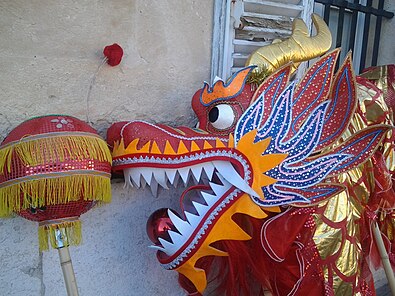Thoughts on Waldorf Traditions
As I mentioned a few days ago, I've been editing the Waldorf Education article on Wikipedia. There is a core group of editors, both supportive and critical of Waldorf, who have been involved for many months, working to improve the article's neutrality and breadth of content.
One of the editors who (if we were taking sides outright) would be on the "con" side, has pointed out that in many Waldorf schools, things are done out of tradition or dogmatic following of anthroposophy, the spiritual philosophy that is the basis for Waldorf methods. I've found this to be true as well.
One big example is the Michaelmas festival, which I wrote about here this autumn. I love this festival, which comes at my favorite time of year. I won't go into much detail about it, but the essence of the imagery is that Michael the Archangel overcomes the dragon. There are many metaphorical layers to this image: light vs. dark, spirituality vs. materialism, truth vs. deception.
Most (if not all) Waldorf schools in the US celebrate this festival, as I'm sure do most European ones. This festival is greatly appreciated in the anthroposophical world, and was lectured on many times by Rudolf Steiner, the creator of Waldorf education and anthroposophy.
However, I think this festival is currently celebrated by schools as a matter of tradition, where many other autumn festivals could be worked with equally well. This kind of tradition, coming from Steiner's (and the first Waldorf school's) Western European and Christian background, has been criticized as being overly eurocentric and Christian given the multicultural nature of modern America.
Steiner admonished us to think freely at all times, never to follow dogma or a guru blindly in place of our own free will. If we think freely about the Michaelmas festival, we may see that it is a celebration of light, of spirit. Many other festivals, or even newly created celebrations, could just as effectively represent these universal concepts. Several that come to mind are Hannukah, Divali, and Samhain. Extending the image to harvest time as a gathering of cosmic light into our food, I think of Sukkot, and Lughnasadh.
Don't get me wrong, I think the festivals as celebrated in Waldorf schools are wonderful, full of rich imagery that speaks to our spirits. And if Waldorf schools choose Christian European festivals, I have no problem with that in and of itself if that is the school's conscious choice, perhaps reflecting the composition of the student body. My problem comes when these festivals (and other practices) are chosen simply out of blind tradition, and do not truly speak to the multitude of cultures reflected in our population.




4 comments:
Well, I just think it is too bad in this well crafted statement that you chose to use an image of a Chinese dragon. I know I am nit-picking here, but the Chinese dragon in that culture represents wisdom. So why would you want to vanquish that?
HMH: I know, sorry about that. I couldn't find an uncopyrighted western-style dragon image before I had to save the post and get the kids up from nap! And I originally was going to bring in the Chinese mid-autumn moon festival, but the symbolism didn't work.
Well, at least you know the difference! You would be amazed at how ignorant many of the people I see on a regular basis are about mythology of any sort.
I have a friend who is an anthroposophist, and I find the whole philosophy quite intriguing. I have been taking some classes in oil dispersion bath therapy. Very very cool, very effective, very esoteric and difficult to explain to the general public.
Hmm. A four-toed dragon. I seem to remember that Chinese dragons aren't universally good and did a little googling. Found this:
"the evil dragons are those introduced by the Buddhists, who applied the current dragon legends to the nagas inhabiting the mountains. These mountain nagas, or dragons (perhaps originally dreaded mountain tribes), are harmful..." Ancient Tales and Folklore of China, pg 208."
source.
So maybe its a naga? Who knows?
Anyway, fascinating post. Nice to hear that the whole editorial crisis seems to be moving a little.
Post a Comment